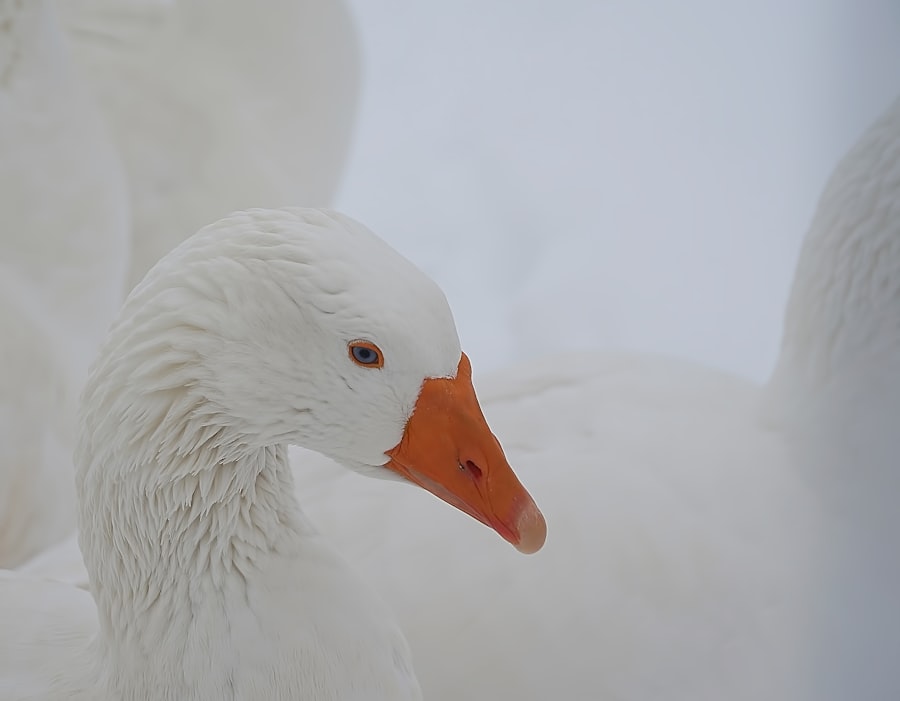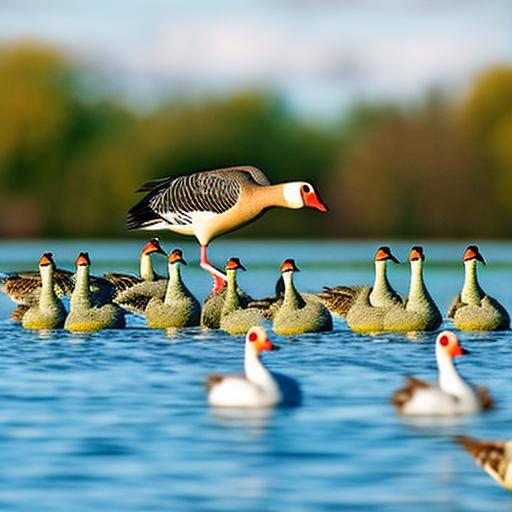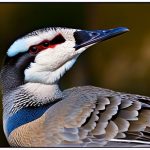The presence of geese in urban areas has become a growing problem in recent years. These birds are attracted to urban areas due to the abundance of food sources and lack of natural predators. However, it is important to address this issue in a humane manner, as geese are living creatures that deserve respect and compassion. In this article, we will explore various methods for deterring geese from urban areas while ensuring their well-being.
Key Takeaways
- Geese are social animals and tend to congregate in areas with water and food sources.
- Physical barriers such as fences and netting can be effective in keeping geese away from certain areas.
- Visual and auditory deterrents such as scarecrows and loud noises can also be effective in deterring geese.
- Removing food sources such as spilled grain and grass clippings can discourage geese from staying in an area.
- Landscaping changes such as planting tall grasses and shrubs can make an area less attractive to geese.
Understanding the behavior of geese
Geese are attracted to urban areas for several reasons. One of the main factors is the availability of food sources such as grass, grains, and garbage. Urban areas often have well-maintained lawns and parks that provide an ample food supply for geese. Additionally, the lack of natural predators in urban environments makes it easier for geese to thrive and reproduce.
The behavior of geese also plays a role in their presence in certain areas. Geese are social animals that prefer to live in large groups called flocks. They are highly adaptable and can quickly learn and remember patterns and routines. Once they find a suitable location with abundant food and minimal disturbances, they are likely to return year after year.
Creating physical barriers to deter geese
One effective method for deterring geese from urban areas is the use of physical barriers. These barriers can be installed to prevent geese from accessing certain areas such as lawns, ponds, or gardens. Some common types of physical barriers include fences, netting, and hedges.
Fences are a popular choice for keeping geese out of specific areas. They can be made from various materials such as metal or plastic and can be installed at different heights depending on the size of the geese. Fences should be at least three feet high to prevent geese from jumping over them.
Netting is another option for deterring geese. It can be installed over ponds or other water bodies to prevent geese from landing and swimming. Netting should be securely fastened to prevent geese from getting tangled or trapped.
Hedges can also be used as a natural barrier to deter geese. They provide a physical barrier while also adding aesthetic value to the landscape. However, hedges require regular maintenance to ensure they remain dense and impenetrable.
Using visual and auditory deterrents
Visual and auditory deterrents can also be effective in deterring geese from urban areas. These deterrents work by creating a sense of danger or discomfort for the geese, making them less likely to stay in the area.
One common visual deterrent is the use of scarecrows. Scarecrows can be placed in areas where geese are likely to gather, such as lawns or gardens. The presence of a scarecrow can create the illusion of a predator, causing geese to avoid the area.
Another visual deterrent is the use of reflective objects such as shiny tape or balloons. These objects create flashes of light that can startle and deter geese. They can be hung near areas where geese are unwanted, such as windows or balconies.
Auditory deterrents can also be effective in deterring geese. These deterrents produce loud noises or sounds that mimic natural predators, causing geese to feel threatened and leave the area. Some examples of auditory deterrents include ultrasonic devices, bird distress calls, and predator calls.
Removing food sources to discourage geese
One of the most effective ways to discourage geese from urban areas is by removing their food sources. Geese are attracted to areas with abundant food, so by eliminating these food sources, they are less likely to stay in the area.
One important step is to properly dispose of garbage and food waste. Geese are opportunistic feeders and will scavenge for food in garbage cans and dumpsters. By ensuring that garbage is properly sealed and disposed of, geese will have less incentive to stay in the area.
It is also important to limit the availability of grass and grains, which are common food sources for geese. This can be done by regularly mowing lawns and removing fallen fruits or grains from the ground. Additionally, using bird feeders that are designed to deter geese can help prevent them from accessing bird food.
Implementing landscaping changes to discourage geese

Making changes to the landscape can also help discourage geese from urban areas. By altering the environment, it becomes less attractive and suitable for geese to inhabit.
One effective landscaping change is the installation of rocks or gravel in areas where geese are unwanted. Geese prefer grassy areas where they can easily graze, so by replacing grass with rocks or gravel, they are less likely to stay in the area.
Another option is to plant vegetation that is unappealing to geese. Certain plants, such as tall grasses or prickly shrubs, can deter geese from landing or grazing. These plants provide a physical barrier and make it difficult for geese to access food sources.
However, it is important to note that landscaping changes should be carefully considered and implemented. Some changes may have unintended consequences, such as attracting other wildlife or negatively impacting the aesthetics of the area.
Using repellents to keep geese away
Repellents can be an effective tool for keeping geese away from urban areas. These substances create an unpleasant taste or smell that deters geese from landing or feeding in the area.
One common type of repellent is a chemical spray that can be applied to grass or other surfaces. These sprays contain substances that are safe for humans and pets but repel geese. They create an unpleasant taste when ingested by geese, causing them to avoid the area.
Another type of repellent is a visual deterrent that uses predator markings or eyespots. These markings create the illusion of a predator, making geese feel threatened and less likely to stay in the area. These visual deterrents can be applied to surfaces such as lawns, roofs, or fences.
It is important to choose repellents that are safe for the environment and do not harm other wildlife or pets. Additionally, repellents should be applied according to the manufacturer’s instructions to ensure their effectiveness.
Encouraging natural predators of geese
One natural and humane method for controlling the geese population is by encouraging natural predators. Natural predators help keep the geese population in check by preying on them and reducing their numbers.
One common predator of geese is the coyote. Coyotes are opportunistic hunters and will prey on geese if given the opportunity. By creating suitable habitats for coyotes, such as providing dense vegetation or water sources, they are more likely to inhabit the area and help control the geese population.
Other natural predators of geese include foxes, raccoons, and birds of prey such as hawks or owls. By preserving natural habitats and providing nesting sites for these predators, they can help keep the geese population in balance.
Educating the community about geese management
Educating the community about geese management is crucial for long-term success in deterring geese from urban areas. By raising awareness and providing information about the importance of humane methods, community members can actively participate in geese management efforts.
One way to educate the community is through workshops or seminars. These events can provide information about geese behavior, the impact of their presence in urban areas, and effective methods for deterrence. Community members can learn how to identify signs of geese presence, how to implement deterrent methods, and how to report any issues or concerns.
Another way to educate the community is through informational materials such as brochures or flyers. These materials can be distributed in public places such as libraries, community centers, or schools. They can provide information about geese behavior, the importance of humane methods, and how community members can contribute to geese management efforts.
Seeking professional help for geese control
In some cases, it may be necessary to seek professional help for geese control. Professionals who specialize in wildlife management can provide expertise and guidance in implementing effective and humane methods for deterring geese.
One type of professional that can be hired is a wildlife biologist or ecologist. These professionals have a deep understanding of wildlife behavior and can provide recommendations for geese management based on scientific research and best practices.
Another type of professional that can be hired is a wildlife control operator. These professionals are trained in safely and humanely removing or deterring wildlife from urban areas. They can assess the situation, implement appropriate methods, and monitor the effectiveness of the deterrence efforts.
Adopting humane methods for geese deterrence
It is important to emphasize the use of humane methods for geese deterrence. Geese are living creatures that deserve respect and compassion, and it is our responsibility to ensure their well-being while addressing the issue of their presence in urban areas.
Humane methods include physical barriers, visual and auditory deterrents, removing food sources, implementing landscaping changes, using repellents, encouraging natural predators, and seeking professional help. These methods prioritize the safety and well-being of geese while effectively deterring them from urban areas.
In conclusion, the presence of geese in urban areas has become a growing problem that needs to be addressed in a humane manner. By understanding the behavior of geese and implementing effective deterrence methods, we can create a balance between human needs and wildlife conservation. It is crucial to prioritize the well-being of geese and adopt humane methods for their deterrence. By working together as a community and seeking professional help when needed, we can successfully manage the geese population in urban areas while ensuring their welfare.
If you’re looking for ways to keep geese away from your property, you might also be interested in learning how to create a safe and comfortable environment for your chickens. One important aspect of chicken coop maintenance is ensuring that the coop stays warm during colder months. Check out this article on Poultry Wizard that discusses the benefits of using a heater for a chicken coop: https://poultrywizard.com/keeping-chickens/heater-for-a-chicken-coop/. Additionally, if you’re considering building or renovating a chicken coop, it’s crucial to choose the right flooring material. Discover the different options available and their advantages in this informative article: https://poultrywizard.com/keeping-chickens/floor-of-chicken-coop/. Lastly, if you’re looking for some inspiration for your chicken coop design, take a look at the unique and creative Hannah Montana Chicken Coop featured in this article: https://poultrywizard.com/keeping-chickens/hannah-montana-chicken-coop/.
FAQs
What are geese?
Geese are waterfowl birds that belong to the family Anatidae. They are known for their long necks, webbed feet, and distinctive honking sound.
Why do geese become a problem?
Geese can become a problem when they invade public spaces, such as parks, golf courses, and residential areas. They can cause damage to property, leave droppings everywhere, and pose a threat to human health.
What are some ways to keep geese away?
There are several ways to keep geese away, including using decoys, installing fencing, using repellents, and modifying the landscape to make it less attractive to geese.
What are some natural repellents for geese?
Some natural repellents for geese include planting certain types of vegetation, such as tall grasses and shrubs, using noise deterrents, such as wind chimes and predator calls, and using visual deterrents, such as reflective tape and scarecrows.
Is it legal to harm geese?
No, it is not legal to harm geese in most cases. Geese are protected under federal and state laws, and harming them can result in fines and other penalties. It is important to use humane methods to keep geese away.
Meet Walter, the feathered-friend fanatic of Florida! Nestled in the sunshine state, Walter struts through life with his feathered companions, clucking his way to happiness. With a coop that’s fancier than a five-star hotel, he’s the Don Juan of the chicken world. When he’s not teaching his hens to do the cha-cha, you’ll find him in a heated debate with his prized rooster, Sir Clucks-a-Lot. Walter’s poultry passion is no yolk; he’s the sunny-side-up guy you never knew you needed in your flock of friends!







